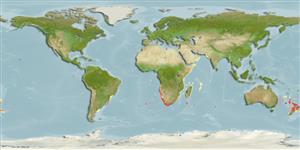Environment: milieu / climate zone / depth range / distribution range
Ecology
Marine; demersal; depth range 40 - 800 m (Ref. 59152), usually 200 - 800 m (Ref. 59152). Subtropical
Southern hemisphere: off southern Africa (from Walvis Ridge and off Namibia to Madagascar Ridge); Australia (Western Australia to northern New South Wales); off New Zealand, Norfolk Island Ridge; and Rio Grande Plateau.
Size / Weight / Age
Maturity: Lm ? range ? - ? cm
Max length : 33.0 cm TL male/unsexed; (Ref. 6651)
Short description
Identification keys | Morphology | Morphometrics
Specimens usually collected by bottom trawlers at 200 to 800 m depth; longlines between 40 to 100 m depth (Ref. 59152).
Life cycle and mating behavior
Maturity | Reproduction | Spawning | Eggs | Fecundity | Larvae
Heemstra, P.C., 1986. Uranoscopidae. p. 735-736. In M.M. Smith and P.C. Heemstra (eds.) Smiths' sea fishes. Springer-Verlag, Berlin. (Ref. 6651)
IUCN Red List Status (Ref. 130435: Version 2025-1)
Threat to humans
Harmless
Human uses
Fisheries: bycatch
Tools
Special reports
Download XML
Internet sources
Estimates based on models
Preferred temperature (Ref.
123201): 5.2 - 14.4, mean 9.4 °C (based on 169 cells).
Phylogenetic diversity index (Ref.
82804): PD
50 = 1.0000 [Uniqueness, from 0.5 = low to 2.0 = high].
Bayesian length-weight: a=0.00617 (0.00263 - 0.01447), b=3.11 (2.90 - 3.32), in cm total length, based on LWR estimates for this (Sub)family-body shape (Ref.
93245).
Trophic level (Ref.
69278): 4.2 ±0.8 se; based on size and trophs of closest relatives
Resilience (Ref.
120179): Medium, minimum population doubling time 1.4 - 4.4 years (Preliminary K or Fecundity.).
Fishing Vulnerability (Ref.
59153): Low vulnerability (23 of 100).
🛈
